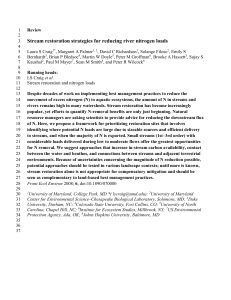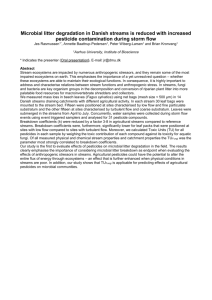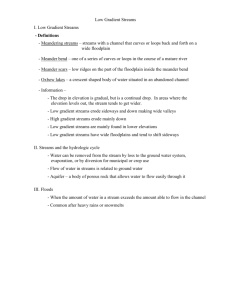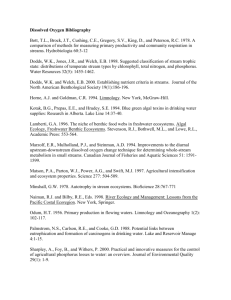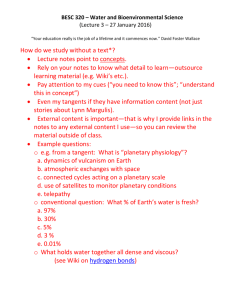Summary - Latvijas Universitāte
advertisement
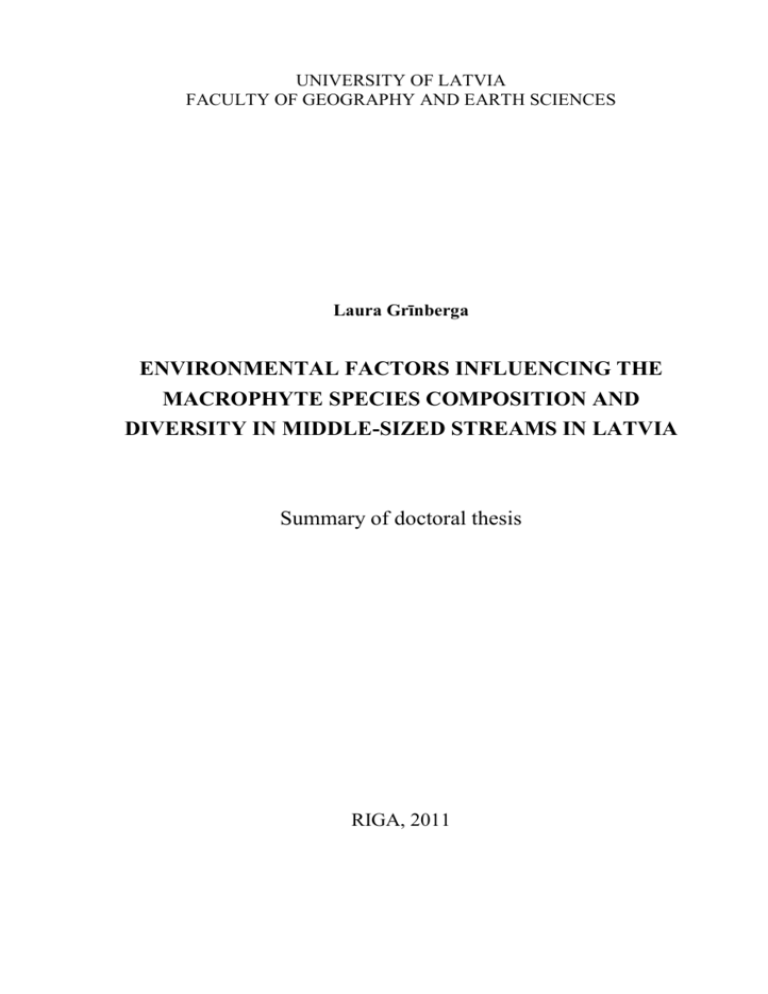
UNIVERSITY OF LATVIA FACULTY OF GEOGRAPHY AND EARTH SCIENCES Laura Grīnberga ENVIRONMENTAL FACTORS INFLUENCING THE MACROPHYTE SPECIES COMPOSITION AND DIVERSITY IN MIDDLE-SIZED STREAMS IN LATVIA Summary of doctoral thesis RIGA, 2011 The research was carried out at the University of Latvia, Faculty of Geography and Earth Sciences, Department of Environmental Sciences during the period from 2006 to 2011. The study was funded by the European Social Fund (ESF) (agreement no.2009/0138/1DP/1.1.2.1.2/09/IPIA/VIAA/004 and Faculty of Geography and Earth Sciences, University of Latvia. SCIENTIFIC SUPERVISOR Asoc. prof. Dr.biol. Gunta Spriņģe DOCTORAL COMMITTEE: Prof . Dr. biol. Viesturs Melecis (University of Latvia), chairman Prof. Dr. habil. chem. Māris Kļaviņš (University of Latvia) Asoc. prof. Dr. biol. Gunta Spriņģe (University of Latvia), padomes zinātniskā sekretāre Prof. Dr. geogr. Oļģerts Nikodemus (University of Latvia) Dr. geogr. Solvita Rūsiņa (University of Latvia) Dr. biol. Ivars Druvietis (University of Latvia) OPPONENTS: Prof. Dr. biol. Viesturs Melecis (University of Latvia) Dr. habil. geogr. Māris Laiviņš (University of Latvia, Institute os Biology) Dr. biol. Egita Zviedre (Natural History Museum of Latvia) The defence of the doctoral thesis will be held on 21st July, 2011, at 2 p.m., in a public s session of the Doctoral Committee at the Faculty of Geography and Earth Sciences, 10 Alberta Street, Riga. The dissertation is available at Scientific Library of University of Latvia, 4 Kalpaka blvd. 2 INTRODUCTION Streams are tightly related to environment and its natural and anthropogenic processes. Streams have had a particular role in human history, therefore, in order to adjust them to human needs they are often significantly influenced and modified. Over the last decades, more and more attention is paid to research of biological processes in rivers and conservation and restoration of riparian environments. In understanding the long-term changes in freshwater ecosystems, the composition and diversity of aquatic plants (macrophytes) are considered as one of the most significant indicators of the ecological quality of waters. In comparison to other organisms, macrophytes are slower in reacting to environmental changes, however, they are suitable indicators in assessments of long-term changes. The role of macrophytes in aquatic environments and the possibility to use them as indicators in assessing the water quality attracts more and more attention worldwide. It is important to understand the regional peculiarities of the indicative role of vegetation in different environments, because the implication of bioindicators differs in various regions (Onaindia et al., 2005). In order to ensure a sustainable use of water resources using unified principles in their protection and the same principles of legislative instruments throughout the European Union, the Water Framework Directive 2000/60/EC was adopted in 23 October 2000. According to the Water Framework Directive, the national Water Management Law (12 September 2002) was adopted, which is the basis of the national Regulation of Cabinet of Ministers No. 858 “On the characterization of surface water bodies, their classification, criteria of quality and order of assessing the anthropogenic impacts”. The regulation includes also the criteria for classification of surface water bodies according to their ecological quality, including the assessment based on macrophyte species composition and abundance. On the same time, the amount of knowledge in Latvia on the stream vegetation is insufficient to develop a suitable method for this task. Development and implementation of a comprehensive method for assessment of ecological quality of streams is not possible without detailed studies of factors defining the species composition and abundance of macrophytes in the Latvian streams and defining the differences among the stream types in Latvia. Numerous studies worldwide prove that macrophytes in streams are tightly related and directly dependent on the environmental conditions. Numerous researchers emphasize that the stream quality assessment using macrophytes as indicators require knowledge on the hydrological regime, geological formation and geomorphological processes of the stream as well as on impacts of natural and anthropogenic origin both in the past and present (Riss & Biggs, 2003; Paal et al., 2007; Tremp, 2007). Several researchers (e.g. Dawson, 1999; Daniel et al., 2006) suggest a need to implement a new approach in studies of stream vegetation based on the morphology of streams. Simple stream classification according to their morphological features would allow a beforehand prediction of the typical species composition in a stream or stream stretch, which would be based on recognition that a species community is formed by species with similar ecological requirements (Kent & Coker, 1992; Harper et al., 2000). Therefore, in understanding the spatial distribution of plant species more 3 attention should be paid to the species relation to environmental factors (Bornette et al., 1994; Ali et al., 1999; Dawson & Szoszkiewicz, 1999; Willby et al., 2000). Regional studies on various aspects of macrophytes become more frequent all over Europe. According to Baatrup-Pedersen et al. (2006), the macrophyte communities on the European scale and in particular regions, e.g. the Baltic region are different. Streams in Latvia are relatively less affected by human impacts, therefore, the results of studying the Latvian streams might be important also on a European context (Baatrup-Pedersen et al., 2006). This study is aimed at investigation of the aquatic vegetation in middle-sized streams and their characterizing features (substrate type, stream velocity, shading degree, stream width and depth, catchment area, land use types in the river catchment and altitude above the sea level) in Latvia. In this study the national classification system of streams and the parameters for assessing the ecological quality was used. In middle-sized streams, the macrophyte stands are very important component of ecosystem, while in large rivers the macrophyte belts form mainly on the zone along the banks of rivers and often are absent in small streams. The aim of study was to find out the composition and abundance of macrophyte species and influencing factors in the middle-sized streams in Latvia. Objectives: to summarize the existing data material on the macrophytes vegetation in middlesized streams in the territory of Latvia and factors influencing the macrophytes in streams; to carry out a field survey in middle-sized streams in all the territory of Latvia describing the macrophyte species composition and abundance as well as recording the environmental site conditions; to summarize and analyze the results evaluating the relation between the macrophyte species composition and abundance and environmental variables in middle-sized streams in Latvia; to evaluate the possibility to use the macrophytes in indication of stream ecological quality using the existing stream typology. Novelty of the study As a result of this study a data base of stream macrophytes was developed, which is easily joinable to the vegetation data from the other European countries. The data base can be used for further studies of macrophyte distribution and abundance in Latvia. For the first time in Latvia, an analysis of the macrophyte species composition and abundance in relation to environmental variables was done for middle-sized streams. The results prove that the shading degree and substrate type are the most important factors influencing the species occurrence and cover in middle-sized streams. The results are applicable in development of national-scale methods for an assessment of the ecological quality in middle-sized streams in Latvia. 4 Approbation of work Scientific publications 1. Grīnberga L. 2011. Macrophyte species composition in streams of Latvia under different flow and substrate conditions. Estonian Journal of Ecology. Peer-reviewed and accepted for the publication in the journal. 2. Grīnberga L. 2011. Environmental factors influencing the vegetation in middle-sized streams in Latvia. Annali di Botanica (Coenology and Plant Ecology) (Roma). Peer-reviewed and accepted for the publication in the journal. 3. Grīnberga L. 2011. Aquatic vegetation distribution in relation to environmental factors in middle-sized streams in Latvia. Latvijas Universitātes Raksti 762: 26-34. 4. Grinberga L. 2010. Environmental factors influencing the species diversity of macrophytes in middle-sized streams in Latvia. Hydrobiologia 656: 233 – 241. 5. Springe G., Grinberga L., Briede A. 2010. Role of the hydrological and hydromorphological factors in ecological quality of the medium-sized lowland streams. Hydrology Research 41 (3-4): 330 – 337. 6. Grīnberga L., Priede A. 2010. Elodea canadensis in Latvia. Acta Biologica Universitatis Daugavpiliensis 10 (1): 43 – 50. Participation in international scientific conferences 1. 19th International Workshop of European Vegetation Survey, Pecs, Hungary, 29.04.02.05.2010., oral presentation in a conference section Vegetation of European rivers and floodplains. The title of presentation: Environmental factors influencing the formation of vegetation in middle sized streams in Latvia. Abstract was published in Book of Abstracts „Flora, vegetation, environment and land-use at large scale”, 2010: 31. 2. 12th EWRS International Symposium on Aquatic Weeds, Jyvaskyla, Finland, 24.28.08.2009. Oral presentation: Environmental factors influencing the distribution of macrophytes in middle-sized streams in Latvia. Extended abstract was published in: Reports of Finnish Environmental Institute 15/2009: 154. 3. 5th International Conference Research and Conservation of Biological Diversity in Baltic Region, Daugavpils, Latvia, 22-24.04.2009. Oral presentation: Invasion of Elodea canadensis in Latvia. Co-author – Priede A. Abstract was published in Book of Abstracts, „Saule”, Daugavpils, 2009: 50. 4. 22nd Expedition of the Baltic Botanists, Daugavpils, Latvia, 14.-17.07.2008. Oral presentation: Impact of physical features on the distribution of aquatic plants in medium-sized rivers in Latvia. Abstract was published in: Abstracts and excursion guides, 2008: 18. 5. 16th European Vegetation Survey, Rome, Italy, 22.-26.03.2007. Poster presentation: Impacts on aquatic vegetation under climate changes in Latvia: case study of the river Salaca. 6. 5th Symposium for European Freshwater Sciences 8.-13.07.2007. Palermo, Italy. Poster presentation: Aquatic macrophytes in high quality lowland streams in Latvia. Co-authors: Urtāns A., Spriņģe G., Eņģele L. Abstract was published in: SEFS-5 Symposium for European Freshwater Sciences. Abstracts, 2007: 208. 5 1. MATERIAL AND METHODS 1.1. Survey sites In order to represent all middle-sized stream types in Latvia, the stream sites for survey were selected according to the Classifier of water management areas of Latvia (ŪSIK, 2005), so that they represent both pothamal and rithral streams and fall into the category of middle-sized streams in accordance to their size of catchment area. A field survey of aquatic macrophytes was performed in summers 2007-2010 during the vegetation period (20th June to 15th September). In whole territory of Latvia 132 stream sites of 83 streams were investigated (Fig. 1.1.). Sampling sites were selected in possibly less shaded 100 m long stretches typical for the particular stream, the sites were selected on topographical maps (1: 50 000) in advance. Each survey site was supplemented by data of catchment area, altitude and land use data for each study site provided by the University of Latvia, Institute of Geodesy and Geoinformatics. Fig. 1.1. Map of Latvia showing the distribution of survey sites (made by author, using data layers of SIA Envirtotech). 1.2. Methodology of surveys of environmental factors and macrophyte sampling For macrophyte surveys a methodology developed for the project Standardization of River Classification: framework method for calibrating different biological survey results against ecological quality classifications to be developed for the Water Framework Directive (STAR) (Furse et al., 2006) was used. Macrophyte sampling and sample processing was done according to the STAR protocols (Dawson, 2002), developed for building the methodology of Great Britain (Holmes et al., 1999). According to the method the following environmental parameters were recorded: substrate material, shading, stream velocity, stream width and water depth of the selected stretch. The sediment type was estimated visually and recorded in field survey form recording the percentage of stones and boulders (>64 mm), gravel (2-64 mm), sand (0.06-2 mm), fine silt. Three categories for estimation of the degree of shading on the water surface were used: 1 = no shading, 2 = shading present (<33 %), 3 = extensive shading (>33%). Stream velocity was estimated in following four categories: 1 = fast flowing (>0.4 m/s), 2 = medium fast flowing (0.2-0.4 m/s), 3 = slow flowing (<0.2 m/s), 4 = no perceptible flow. Water depth after measurements was divided into four classes: 1 = <0.25 m; 2 = 0.25-0.5 m; 3 = 0.5-1 m; 4 = >1m. A five-point scale was used for estimation of the stream width: 1 = < 1 m, 2 = 1-5 m; 3 = 5-10 m; 4 = 10-15 m; 5 =15-20 m. The abundance of macrophyte species was recorded together with their percentage cover where: 1: <0.1%, 2: 0.1-1%, 3: 1-2.5, 4: 2.5-5%, 5: 5-10%, 6: 10-25%, 7: 25-50%, 8: 5075%, 9: >75%. The total cover of macrophytes of the selected stretch was estimated by using description of vegetation in the field survey form. Study area was observed by wading over the whole stream bed or from the banks (mostly both sides) in deeper streams, where a rake with a long handle was used for taking plants from the water. The macrophyte assessment was based on the presence and cover of submerged, emergent, floating-leaved, free-floating vascular plants, bryophytes and charophytes. All taxa were identified by the surveyor using keys: “Latvijas PSR augu noteicējs” (Pētersone & Birkmane, 1980), „Süßwasserflora von Mitteleuropa” (Casper & Krausch 2008a; Casper & Krausch, 2008b), „Den nya nordiska floran” (Mossberg & Stenberg, 2003), „Rosliny wodne i bagienne” (Klosowscy, 2007). Sparganium erectum was treated collectively as sensu lato (s.l.). Doubtful species were sampled and herbarized and identified by Dr.biol. Ģ.Gavrilova (University of Latvia, Institute of Biology, family Potamogetonaceae) and Dr.biol. E. Zviedre (Natural History Museum of Latvia, family Characeae), Taxonomy and nomenclature follows Gavrilova & Sulcs (1999), Abolina (2001) and Zviedre (2007). Collected vascular plants and charophytes were deposited in the Natural History Museum of Latvia (LDM) (Charophyta), and the vascular plants and bryophytes in the herbarium of Institute of Biology, University of Latvia (LATV). 7 1.3. Data analysis The described relevés of plant communities were stored in TURBOVEG (Hennekens, 1995) data base and used for further analysis. Relevés were classified according to the TWINSPAN (Two-way indicator species analysis) software (Hill & Šmilauer, 2005). The relevés were grouped according to the similarity of species composition derived from the TWINSPAN division into groups. Species with the highest occurrences (constancy) were chosen as the character species for the particular group. Species with high constancy are those, which are frequent in the vegetation unit (species of high constancy are those with occurrence above 40% of relevés, species with very high constancy are those with occurrence above 80% of relevés) (Chytrý, 2007). Data analyses were done using Microsoft Excel software. In analysing the presence of species in relation to environmental factors, only species occurring in ten or more investigated stretches were selected. Species identified to the genus level of genus Potamogeton were excluded from the analysis. In data analysis species abbreviations of their Latin names were used. Relationships among environmental and vegetation variables were evaluated by Pearson correlation coefficients calculated by SPSS 12.0.1. (SPSS Inc, 2000). In calculation of the correlation coefficients, the categorical values for environmental factors were used taken from the field survey forms and land use data. Analysis of variance (ANOVA) was applied using SPSS to test the differences between the cover of macrophytes and the number of taxa in five stream groups. Analysis of single range test (Fisher’s least significant difference) in programme SPSS were done in order to define the relation among the vegetation parameters (total number of species per investigated stretch and total cover of macrophytes) and the environmental factors. Relationships between the total number of species and macrophyte cover in the investigated stretch as well as cover, land use types and cathment area were analyzed using multiple regression analysis. Ordination of species communities and species ordination was performed using detrended correspondence analysis (DCA), programme package CANOCO for Windows (Lepš & Šmilauer, 2003). The relationships between macrophyte species and environmental factors were analyzed using Canonical Correspondence Analysis (CCA). Species occurring only in one or two stretches of the stream were excluded from the data set. The maps of distribution depicting the surveyed sites, macrophyte cover and distribution of species number in Latvia were prepared using ESRI ArcGis programme and data layers provided by SIA Envirotech. 8 2. RESULTS AND DISCUSSION 2.1. Macrophyte species composition and abundance In total, 58 vascular plant, charophyte and bryophyte taxa were found in 132 strethes of 83 middle-sized streams in Latvia (Fig. 1.1.). 51 taxa were identified to species level, while 7 taxa - to genus level (Table 2.1.) Table 2.1. Macrophyte taxa and their abundance in the investigated stream stretches. Abundance (N) Emergent macrophytes Sparganium emersum Sparganium erectum Phalaroides arundinacea Alisma plantago-aquatica Sium latifolium Mentha aquatica Sagittaria sagittifolia Phragmites australis Scirpus lacustris Veronica anagallis-aquatica Butomus umbellatus Rorippa amphibia Glyceria fluitans Iris pseudacorus Equisetum fluviatile Glyceria maxima Typha latifolia Berula erecta Hippuris vulgaris Cicuta virosa Acorus calamus Sparganium minimum Sparganium sp. Floating-leaved macrophytes Nuphar lutea Potamogeton natans Nymphaea sp. Nymphaea candida Free-floating macrophtyes Lemna minor Lemna trisulca Spirodela polyrhiza Lemna gibba Hydrocharis morsus-ranae 78 65 64 55 40 37 36 30 30 23 22 22 16 15 14 11 10 9 7 4 3 2 1 79 10 1 1 Abundance (N) Submerged macrophyte Fontinalis antipyretica Elodea canadensis Veronica beccabunga Potamogeton alpinus Potamogeton perfoliatus Callitriche sp. Batrachium sp. Potamogeton praelongus Potamogeton lucens Myriophyllum spicatum Potamogeton sp. Chara globularis Batrachium trichophyllum Chara sp. Potamogeton berchtoldii Amblystegium riparium Potamogeton crispus Potamogeton gramineus Hottonia palustris Chara contraria Potamogeton pectinatus Utricularia vulgaris Callitriche stagnalis Callitriche cophocarpa Batrachium circinatum Utricularia sp. 48 44 43 23 22 19 16 12 11 11 10 6 5 4 3 3 2 2 2 2 2 1 1 1 1 1 46 25 24 6 3 9 In more than a half of the investigated stretches yellow water-lily Nuphar lutea and unbranched bur-reed Sparganium emersum were found, as well as some emergent macrophyte species – branched bur-reed Sparganium erectum, reed canary-grass Phalaroides arundinacea and water plantain Alisma plantago-aquatica. The most frequent species found in all investigated stretches are shown in Table 2.2. Table 2.2. The most common species (% of all sites) in the investigated stream stretches. M acrophyte species Occurrence (%) of all investigated stretches Nuphar lutea 60 Sparganium emersum 59 Sparganium erectum 49 Phalaroides arundinacea 48 Alisma plantago-aquatica 42 Fontinalis antipyretica 36 Lemna minor 35 Elodea canadensis 33 Veronica beccabunga 32 Sium latifolium 30 Mentha aquatica 28 Sagittaria sagittifolia 27 Phragmites australis 23 Scirpus lacustris 23 Some species were found only in one or few investigated stream stretches, e.g. greater bladderwort Utricularia vulgaris, water starwort Callitriche cophocarpa, common water starwort C. stagnalis, fan-leaved water crowfoot Batrachium circinatum and small waterlily Nymphaea candida were among the rarest species. Species abundance in the stream stretches was variable. Higher abundance was characteristic for submerged macrophyte species, which usually form larger stands and occupy at least 5% of the sampling plot. Although being frequent in the investigated stretches, some species form small stands and present low percentage (cover of individual species varies between 1-5% of sampling plot), for example, water plantain Alisma plantago-aquatica, which occurred in 42% of sites, brooklime Veronica beccabunga, which occurred in 32% of sites, and greater water-parsnip Sium latifolium, which occurred in 30% of sites. The dominance of a sigle species was observed rarely. In this study, dominance of a 10 single species was found only for fat duckweed Lemna gibba, which usually covers on average 20% - 60% of the stream stretch. Among the most frequent macrophyte species, emergent macrophytes prevail. Sparganiaceae is the species-richest familiy – along with the dominating Sparganium emersum and S. erectum, at the same one site also relatively rare species – least bur-reed S. minimum was found. Among the submerged macrophytes the highest species number (8 species) was found for the pondweed family Potamogetonaceae. The most frequent pondweed species are red pondweed Potamogeton alpinus (occurred in 14% of sites), perfoliate pondweed P. perfoliatus (12% of sites) and long-stalked pondweed P. praelongus (6% of sites). Number of species varies among the stream stretches; on average 8 macrophyte taxa per stretch were found. The highest species number found in the stream Misa (22 taxa), as well as in two stretches in the stream Džūkste (Kauguru canal) and lower reach of the stream Svitene (in all three sites 19 taxa were found in each). In developing the assessment system of stream ecological quality for Latvia, one must bear in mind that in the European assessment systems (e.g. Haury et al., 1994; Holmes et al., 1999) considerable proportion in species composition is filled up by species of the families Callitrichaceae and Ranunculaceae, while in the Latvian middle-sized streams species of these families is low represented, and these plant species almost never form large stands. 2.2. Vegetation cover Vegetation cover in the investigated stream stretches varied from 1 to 100%, in more than a half (54% of sites) macrophyte cover was lower than 30%, while 26% of the stretches were heavily overgrown with cover varying from 70 to 100. There was a significant positive correlation among the species number and macrophyte cover. However, often high species richness was found also in stretches with low (530%) macrophyte cover. In streams with low macrophyte cover (1 to 2%) also the total number of species was the lowest (1 to 3 species). Rarely, a well-pronounced dominance of few species was found. The highest number of species was found in streams with high macrophyte cover (90 to 100%). In this study, wide, monodominant stands of a single macrophyte species were not observed, e.g. Canadian pondweed Elodea canadensis, recognized as highly invasive species and frequently forming monodominant stands in water bodies and streams in many countries worldwide, was not found as aggressive species in the streams of Latvia (Grīnberga & Priede, 2010). 11 2.3. Relation among environmental factors and macrophyte species composition and abundance of streams 2.3.1. Relation between environmental factors and macrophyte species composition All relevés were classified into 3 groups according to TWINSPAN division into groups based on the similarity of species composition. Species with the highest constancy were selected as the character species. Group 1 – dominating species is Nuphar lutea (56 relevés). The most frequent species in this goup are yellow water-lily Nuphar lutea, branched bur-reed Sparganium erectum, common reed Phragmites australis, arrowhead Sagittaria sagittifolia, common club-rush Scirpus lacustris, flowering rush Butomus umbellatus, perfoliate pondweed Potamogeton perfoliatus and shining pondweed P. lucens. According to principles of phytosociological classification (Dierssen, 1996) this group corresponds to the class Phragmitetea, order Phragmitetalia, alliance Sparganietum erecti. These communities are characteristic for fast to slow flowing rivers and standing waters. This community forms stands in the littoral of relatively deep and slow streams (mostly deeper than 0.5 m), as well as in the entire cross-section of shallower and faster rivers (submerged growing form is charasteristic for Scripus lacustris, Butomus umbellatus, Sagittaria sagittifolia). In literature it is remarked that these communities appear to be tolerant to elevated levels of phosphate and have wide pH range (Dawson & Szoszkiewicz, 1999). Group 2 – dominating species is Sparganium emersum (69 relevés). The most frequent species in this goup are unbranched bur-reed Sparganium emersum, brooklime Veronica beccabunga, water plantain Alisma plantago-aquatica and common water moss Fontinalis antipyretica. In this group, pondweeds Potamogeton alpinus and P. praelongus, water starworts Callitriche sp. and thread-leaved water crowfoot Batrachium trichophyllum are also frequent. However, in correspondence with literature (Dierssen, 1996), this group does not precisely corresponds to any of the described riparian communites. TWINSPAN division to lower hierachical units suggest that the group of relevés should be further diveded into two sub-groups: the community of gravelly-stony streams could be dividend, thus corresponding to the class Fontinaletea antipyreticea, as well as community that corresponds to the class Potamogetonetea, order Potamogetonetalia. Plant communities of class Fontinaletea antipyreticea usually develop in the central parts of parly and extensively shady and fast flowing streams, on streams with steep bed-slopes with water depth up to 0.5 m. Dawson & Szoszkiewicz (1999) noted the tolerance of this species to low pH and possitive correlation with low nitrate level of water. Plant communities of the class Potamogetonetea, order Potamogetonetalia occurs in deeper parts of mesotrophic and eutrophic rivers. In this order, a plant community with Spargnanium emersum was dividend, which represents a large proportion of sumerged leaves of plants (Dierssen, 1996). In the middle-sized streams of Latvia such species composition occurs in medium fast and fast 12 flowing streams with sandy substrate. Both species communities are cahracterising waters with high transparency (Dawson & Szoszkiewicz, 1999). Group 3 – dominating taxa are Lemna sp. (9 relevés). The most frequent species in this goup are yellow water-lily Nuphar lutea, greater duckweed Spirodela polyrhiza, Canadian pondweed Elodea canadensis, common duckweed Lemna minor, fat duckweed Lemna gibba, branched bur-reed Sparganium erectum, ivy-leaved duckweed L. trisulca and reed sweet-grass Glyceria maxima. According to the phytosociological approach (Dierssen, 1996), this group corresponds to the class Lemnetea, order Lemnetalia minoris with typical species Lemna minor, L. trisulca and L. gibba. This species community is typical in shallow and medium deep, standing or slow flowing waters on detritus and silty substrate that is usually covered with gravel and sand. Fig. 2.1. shows the DCA ordination of the relevés and position of the TWINSPANdivided species groups in the ordination space. 13 2.3.2. Relationships between environmental factors and macrophyte abundance in streams In order to evaluate the impact of environmental factors to total number of macrophyte species, Pearson correlation coefficients calculated. Significant correlation was found among most of environmental variables. Stream depth was positively correlated with substrate and stream width. Stream velocity was negatively correlated with the catchment area. Analysis showed positive correlations between the number of taxa and stream width and catchment area, while the number of taxa and macrophyte cover negatively correlated with shading and altitude. Both number of taxa and macrophyte cover negatively correlated with substrate types. The results of the study reveals that one of most important factors affecting macrophytes species number and cover in medium sized streams in Latvia is substrate conditions, shading as well as altitude. Significant negative correlation among these parameters was found. Significant positive correlation was found between species number and stream width, as well as between species number and cathment area. 2.1.att. DCA ordination of macrophyte species (triangles simbolize disposition of 14 species) G1 – Nuphar lutea species group, G2 – Sparganium emersum species group, G3 – Lemna sp. species group (1st axis explain 38.4 %, 2nd axis 23.9 %, 3rd axis 20% of total data dispersion). The results of the study reveal that one of most important factors affecting macrophytes in medium sized streams in Latvia is shading, especially in upstreams. In 22% of the investigated stretches shading exceeded 33% of stream bed. The substrate type is another crucial factor influencing the number of species and macropophyte cover. In fast flowing streams on sandy substrate the macrophyte composition is species-poor, in such streams deeply rooted species typically prevail. Also variable depth and mobile riverbed offer unfavourable conditions for macrophyte growth in sandy streams, plant stands are forming mainly in shallower stretches. This corresponds with the experience of investigations in Denmark by Riis et al. (2000), who found that in sandy streams the species richness and diversity of aquatic vegetation is the lowest among the stream types. Substrate stability is a significant controlling factor, because a stable substrate allows rooting and establishment of macrophyte communities (Riis & Biggs, 2003; Haslam, 2006). Substrate composition are closely linked with impact of water velocity, because larger and more heavy particles requires faster current speed to initiate movement, therefore in streams with gravelly-stony substrate for water velocity has less limiting role (Madsen et al., 2001). In Latvia an assessment system for stream macrophytes has not been developed yet. The insufficient data of the macrophyte vegetation hinders both the establishment of a suitable assessment system and an implementation of a proper assessment without knowledge of typical species composition in the Latvian streams. Results of investigations done in Europe and other countries worldwide are not directly aplicable in Latvia, considering that macrophyte species composition are highly variable in European countries (Baatrup-Pedersen et al., 2006). 15 2.4. Classification of streams according to community groups related to certain environmental factors In order to analyze the role of the main factors influencing macrophyte growth in middlesized streams in Latvia, according to the river typology of Latvia and previous analysis of environmental factors, the stream stretches studied were grouped into five groups with different stream velocity and substrates: (1) fast flowing streams on gravelly and stony substrate, (2) slow flowing streams on gravelly and stony substrate, (3) fast flowing streams on sandy substrate, (4) slow flowing streams on sandy substrate and (5) slow flowing streams with soft, silty substrate. The greatest number of macrophyte taxa, the highest species diversity and the highest macrophyte cover was found in streams of Group 2 and Group 1. The lowest Shannon diversity is associated with Group 3. The greatest range of macrophyte cover was associated with Group 2, lower macrophyte cover was found in fast flowing streams on gravelly and stony substrate (Group 1). Streams on sandy substrate (Group 3 and 4) and slow flowing streams with soft, silty substrate (Group 5) are associated with very low macrophyte cover. Streams on gravelly and stony substrate are characteric with shallower depths that along with stable substrate allows rooting and well establishment of macrophyte communities In streams on sandy and soft, silty substrate the growth of macrophytes is frequently limited by water depth – the highest number of deep streams falls into in stream group with soft, silty substrate, these streams often are also narrow and shaded. Distribution of macrophyte ecological groups are analyzed (Fig. 2.2.). In all stream groups emergent plants prevail, while submerged species prevail in streams with gravelly and stony substrate. Commonly, in deeper sites of slow streams with sandy substrate the number of macrophyte species is small, the plants occur mostly in shallower waters. In streams with soft, silty substrates the macrophyte vegetation is formed by sparse cover of helophytes, floating-leaved and submerged plants. 16 Fig. 2.2. Distribution of macrophyte ecological groups. Vegetation distribution and abundance in each group of streams were analyzed (Table 2.3.). In fast flowing streams on gravelly and stony substrate the vegetation in was dominated by Fontinalis antipyretica, Sparganium emersum, S. erectum s.l. and Nuphar lutea. In slow flowing streams on gravelly and stony substrate along with those species also Lemna minor and Elodea canadensis are among the dominant species. In fast flowing streams on sandy substrate Sparganium emersum prevails, this species forms sparse stands of submerged leaves. Elodea canadensis, a species, which is also common in this group, is also to grow on unstable substrate. Slow flowing streams with soft, silty substrate are dominated by littoral macrophyte species (Phalaris arundinacea, Sparganium erectum), as well as Nuphar lutea. 17 Table 2.3. The most common species (% of all sites) in stream groups. Group 1 Group 2 Taxon % Taxon % Fontinalis antipyretica 78 Nuphar lutea 66 Nuphar lutea 70 Sparganium emersum 55 Sparganium emersum 70 Sparganium erectum 53 Alisma plantago-aquatica 65 Lemna minor 50 Sparganium erectum 60 Elodea canadensis 47 Group 3 Group 4 Taxon % Taxon % Sparganium emersum 94 Phalaris arundinacea 78 Alisma plantago-aquatica 41 Sparganium erectum 72 Elodea canadensis 41 Nuphar lutea 67 Phalaris arundinacea 33 Sparganium emersum 56 Veronica b eccab unga 33 Alisma plantago-aquatica 50 Group 5 Taxon % Nuphar lutea 86 Sparganium erectum 59 Sparganium emersum 50 Phalaris arundinacea 41 Lemna minor 36 Results of this study indicate that in streams with sandy substrate stream velocity has a crucial role for forming of macrophyte vegetation. In fast flowing sandy streams of Latvia macrophytes are potentially not suitable element for quality assessment. Due to higher stream velocity, unstable substrate and strong effect of the spring floods conditions for the vegetation formation in fast flowing streams on sandy substrate are inappropriate, thus the definition of the ecological status of a stream by macrophytes requires a certain minimum plant quantity (6 – 10 taxa). However, the absence of macrophytes at a stream site is not necessarily a result of degradation (Schaumburg et al., 2004). If certain plant quantity is not found in this kind of stream, the assessment of the stream is impossible. In that case, the macrophyte component must be excluded of the classification of the entire quality element. This is assumed, that important is to preserve the geomorphological diversity of streams as much as water quality in order to preserve plant diversity, in such way to provide environmental diversity for other aquatic organisms (Makkay et al., 2008). 18 CONCLUSIONS 1. 2. 3. 4. 5. 6. 7. 8. In the Latvian middle-sized streams the number of macrophyte species range from 1 to 22. The largest number of species (15 to 22 species) is found in streams with large vegetation cover. On the same time, monodominant species stands do not form in stream stretches with dense vegetation cover. The most frequent species are Nuphar lutea and Sparganium emersum, which were found in more than half of the surveyed streams. Also Sparganium erectum, Phalaroides arundinacea and Alisma plantago-aquatica are frequent in the Latvian middle-sized streams. In middle-sized streams three vegetation types can be distinguished, each of them being related to specific environmental conditions: a community with the dominant species Nuphar lutea, a community with the dominant species Sparganium emersum, and a community dominated by Lemna sp. The results of this study suggest that in further studies of macrophyte communities in the Latvian streams more attention should be paid to not only species composition and vegetation cover, but also to the analysis of the plant community structure, which might help in developing better classification of streams. Among the factors, substrate type and shading degree has the most significant impact on the number of macrophyte species and cover in the Latvian middlesized streams. Significant positive correlation was found between the number of species and the width of stream as well as between the number of species and catchment area. No significant correlation was found between the velocity of stream and depth of water. Among the land use types, positive correlation was found between the number of species and cover of arable lands in the catchment, while no significant relation was found neither between the land use type, not catchment area. The highest number of species and largest vegetation cover was found in streams with gravelly-stony substrate. The lowest species diversity is related to fast flowing streams width and substrate. In sandy and silty streams the development of macrophyte communities is often limited by the depth of water – the largest proportion of streams was found in the stream group with silty substrate. Silty streams are often narrow and shadowed. In all types of streams, the largest proportion of species is formed by emergent plant species. The proportion of submerged plant species is higher in streams with gravelly-stony substrate. Development of floating-leaved and free-floating plants is limited in fast flowing streams with sandy substrate. The largest proportion of free-floating plant species occur in slow flowing streams with gravelly-stony substrate. The results of this study are well applicable in development of assessment system of ecological quality of the Latvian middle-sized streams. 19 REFERENCES Ali M.M., Murphy K.J. & Aberneth V.J. 1999. Macrophyte functional variables v. Species assemblages as predictors of trophic status in flowing waters. Hydrobiologia 415: 131-138. Āboliņa A., 2001. Latvijas sūnu saraksts. Latvijas Veģetācija 3: 47-87. Baatrup-Pedersen A. & Riis T. 1999. Macrophyte diversity and composition in relation to substratum characteristics in regulated and unregulated Danish streams. Freshwater Biology 42: 375-385. Baattrup-Pedersen A., Larsen S.E. & Riis T., 2003. Composition and richness of macrophyte communities in small Danish streams – influence of environmental factors and weed cutting. Hydrobiologia 495: 171-179. Baattrup-Pedersen A., Szoszkiewicz K., Nijboer R. O'Hare M. & Ferreira T. 2006. Macrophyte communities in unimpacted European streams: variability in assemblage patterns, abundance and diversity. Hydrobiologia 566: 179-196. Baatrup-Pedersen A., Springe G., Riis T., Larsen S.E., Sand-Jensen K. & Kjellerup Larsen L.M. 2008. The search for reference conditions for stream vegetation in northern Europe. Freshwater Biology 53(9): 1890 - 1901. Barendregt A. & Bio A.M.F. 2003. Relevant variables to predict macrophyte communities in running waters. Ecological Modelling 160: 205-217. Best E.P.H. 1995. The impact of mechanical harvesting regimes on the aquatic and shore vegetation in water courses of agricultural areas of the Netherlands. Vegetatio 112: 57-71. Bornette G., Henry C., Barrat M.H. & Amoros C. 1994. Theoretical habitat templet, species traits and species richness: aquatic macrophytesin the Upper Rhone River and its floodplain. Freshwater Biology 31: 487-505. Casper J., Krausch H-D. 2008a. Süßwasserflora von Mitteleuropa, Pteridophyta und Anthophyta Teil 2, Band 24/2, Gustav Fischer Verlag, 2nd Ed., 542 pp. Casper J., Krausch H-D. 2008b. Süßwasserflora von Mitteleuropa, Pteridophyta und Anthophyta Teil 1, Band 23, Gustav Fischer Verlag, 2nd Ed., 406 pp. Chytrý M. (ed.) 2007. Vegetace České republiky. 1. Travinná a keřičková vegetace. Academia, Praha, 526 pp. Clarke S.J. 2002. Vegetation growth in rivers: influences upon sediment and nutrient dynamics. Progress in Physical Geography 26 (2): 159-172. Comin F.A., Romero J.A., Astorga V. & García C. 1997. Nitrogen removal and cycling in restored wetlands used as filters of nutrients for agricultural runoff. Water Science and Tehnology 35: 255-261. Daniel H., Bernez I. & Haury J. 2006. Relationships between macrophytic vegetation and physical features of river habitats: the need for a morphological approach. Hydrobiologia 570: 11-17. Dawson F.H., 1988. Water flow and the vegetation of. running waters. In: Vegetation of Inland Waters (ed. Symoens J.J.). Kluwer Academic Publishers, Dordrecht, 283– 309. Dawson F.H., Raven P.J. & Gravelle M.J. 1999. Distribution of the morphological groups of aquatic plants for rivers in the U.K. Hydrobiologia 415: 123-130. 20 Dawson F.H. & Szoszkiewicz K. 1999. Relationships of some ecological factors with the associations of vegetation in British rivers. Hydrobiologia 415: 117-122. Engelhardt K.A.M. & Ritchie M.E. 2001. Effects of macrophyte species richness on wetland ecosystems and services. Nature 411: 687-689. Fox A.M. 1992. Macrophytes. In Calow P. & Petts G.E. (ed.) The Rivers Handbook Hydrological and Ecological Principles. Blackwell Scientific Publications, Oxford: 216 – 233. Furse M., Hering D., Moog O., Verdonschot P., Johnson R., Brabec K., Gritzalis K., Buffagni A., Pinto P., Friberg N., Murray-Bligh J., Kokes J., Alber R., UsseglioPolatera P., Haase P., Sweeting R., Bis B., Szoszkiewicz K., Soszka H., Springe G., Sporka F. & Krno I. 2006. The STAR project: context, objectives and approaches. Hydrobiologia 566, 3-29. Gavrilova G., Šulcs V, 1999. Latvijas vaskulāro augu flora. Taksonu saraksts. Latvijas Universitātes Bioloģijas institūts, Botānikas laboratorija, Rīga. 136 pp. Grasmück N., Haury J., Léglize L. & Muller S. 1995. Assessment of bio-indicator capacity of aquatic macrophytes using multivariate analysis. Hydrobiologia 300/301: 115-122. Grīnberga L. & Priede A. 2010. Elodea canadensis in Latvia. Acta Biologica Universitatis Daugavpiliensis 10 (1): 43 – 50. Harper D.M. 1992. Eutrophication of freshwaters: principles, problems and restoration. London: Chapman and Hall 327 pp. Harper D.M., Kemp J.L., Vogel B. & Newson M.D. 2000. Towards the assessment of „ecological integrity” in running waters of the United Kingdom. Hydrobiologia 422: 133-142. Haslam S. M. 2006. River Plants: The Macrophytic Vegetation of Watercourses (2 nd revised edition). Cambridge University Press, Cambridge, 438 pp. Haury J., Thiebaut G. & Muller S. 1994. Les groupements rhéophiles des rivières acides du Massif armoricain, des Vosges du Nord et de Lozère – Position dans le contexte Ouest-Européen. In 37th IAVS Symposium on Large area vegetation surveys, Bailleul, France, Colloques Internationnaux de Phytosociologie, 145-168. Hennekens S.M. 1995. TURBO(VEG). Software package for input, processing and presentation of phytosociological data. User’s guide. Wageningen/Lancaster. Hill M.O., Šmilauer P. 2005. TWINSPAN for Windows version 2.3. Centre for Ecology and Hydrology & University of South Bohemia, Huntingdon & České Budějovice. Holmes N. T. H., Newman J. R., Chadd S., Rouen K. J., Saint L., Dawson F.H. 1999. Mean Trophic Rank: A Users Manual, R&D Technical Report E38, Environment Agency of England, Bristol, 134 pp. Janauer G. & Dokulil M. 2006. Macrophytes and algae in running waters, In: Biological monitoring of rivers, Ed. by G. Ziglio, M. Siligardi and G. Flaim, John Wiley & Sons, Ltd., 486 pp. Kent M. & Coker P. 1992. Vegetation description and analysis. A practical approach. Wiley, UK, 354 pp. Klosowscy S.G. 2007. Rosliny wodne i bagienne. Multico,Warszawa. 334 pp. Lepš J. & Šmilauer P. 2003. Multivariate Analysis of Ecological Data using CANOCO. Cambridge: Cambridge University Press, 269 pp. 21 Madsen J.D., Chambers P.A., James W.F., Koch E.W. & Westlake D.F. 2001. The interacion between water movement, sediment dynamics and submersed macrophytes. Hydrobiologia 444: 71-84. Makkay K., Pick F. R. & Gillespie L. 2008. Predicting diversity versus community composition of aquatic plants at the river scale. Aquatic Botany 88 (4): 338 – 346. McCune B. & Mefford J. 1999. Multivariate Analysis of Ecological Data. Version 4.17. MjM Software, Gleneden Beach, Oregon, USA. Ministru kabineta noteikumi Nr. 858 „Noteikumi par virszemes ūdensobjektu tipu raksturojumu, klasifikāciju, kvalitātes kritērijiem un antropogēno slodžu noteikšanas kārtību”. Pieņemti 2004. gada 19. oktobrī. Latvijas Vēstnesis 168 (3116), 22.10.2004. Minshall G.W. 1978. Autotrophy in stream ecosystems. BioScience 28 (12): 767 – 771. Mossberg B., Stenberg L. 2003. Den nya Nordiska Floran. Wahlström & Widstrand, 927 pp. Onaindia M., Amezaga I., Garbisu C. & García-Bikuña B. 2005. Aquatic macrophytes as biological indicators of environmental conditions of rivers in north-eastern Spain. International Journal of Limnology 41 (3): 175-182. Paal J., Trei T. & Viik M. 2007. Vegetation of Estonian watercourses, III. Drainage basins of the Moonsund Sea, the Gulf of Riga and Saarema Island. Annali Botanica Fennici 44: 321-344. Pētersone A. & Birkmane K. 1980. Latvijas PSR augu noteicējs. 2. izd. Zvaigzne, Rīga, 590 pp. Preston C.D. & Croft J.M. 2001. Aquatic plants in Britain and Ireland. Harley Books, Colchester, Essex, 365 pp. Riis T. & Biggs J.F., 2001. Distribution of macrophytes in New Zealand streams and lakes in relation to disturbance frequently and resource supply – a synthesis and conceptual model. New Zealand Journal of Marine and Freshwater Research 35: 255-267. Riis T., Sand-Jensen K. & Larsen S.E. 2001. Plant distribution and abundance in relation to physical conditions and location within Danish stream systems. Hydrobiologia 448: 217-228. Riis T., Sand-Jensen K. & Vestergaard O. 2000. Plant communities in lowland Danish streams: species composition and environmental factors. Aquatic Botany 66: 255272. Riis T. & Biggs J.F., 2003. Hydrologic and hydraulic control of macrophyte establishment and performance in streams. Limnology and Oceanography 48: 14881497. Schaumburg J., Schranz C., Foerster J., Gutowski A., Hofmann G., Meilinger P., Schneider S.& Schmedtje U. 2004. Ecological classification of macrophytes and phytobenthos for rivers in Germany according to the Water Framework Directive. Limnologica 34:283-301. SPSS Inc., 2000. Systat for Windows, Version 10, SPSS Inc., Chicago, IL, USA. Tremp H. 2007. Spatial and environmental effects on hydrophytic macrophyte occurrence in the Upper Rhine floodplain (Germany). Hydrobiologia 586: 167-177. Vereecken H., Baetens J., Viaene P., Mostaert F. & Meire P. 2006. Ecological 22 management of aquatic plants: effects in lowland streams. Hydrobiologia 570: 205210. Zviedre E. 2007. Genus Chara L. in Latvia - freshwater species and their identification. Acta Biologica Universitatis Daugavpiliensis 7 (2): 139-147. Watson D., 1987. Hydraulic effects of aquatic weeds in U.K. rivers. Regulated Rivers 1: 211-227. Willby N.J., Abernethy V.J. & Demars B.O.L. 2000. Attribute-based classification of European hydrophytes and its relationship to habitat utilization. Freshwater Biology 43: 43-74. 23 24
